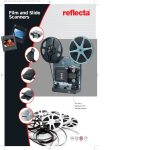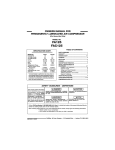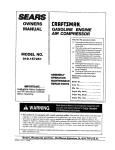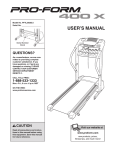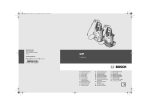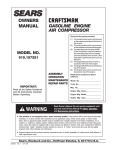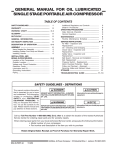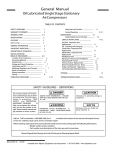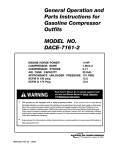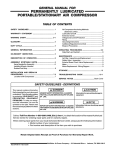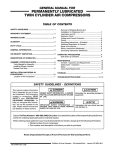Download DeVilbiss MG4-OLENG-2B Troubleshooting guide
Transcript
GENERAL MANUAL FOR OIL LUBRICATED SINGLE STAGE GASOLINE ENGINE AIR COMPRESSOR oduct is not equipped with a spark arr esting muf fler arresting muffler fler.. • This prproduct If the product will be used around flammable materials, or on land covered with materials such as agricultural crops, forest, brush, grass, or other similar items, then an approved spark arrester must be installed and is legally required in the state of California. It is a violation of California statutes section 130050 and/or sections 4442 and 4443 of the California Public Resources Code, unless the engine is equipped with a spark arrestor, as defined in section 4442, and maintained in effective working order. Spark arresters are also required on some U. S. Forest service land and may also be legally required under other statutes and ordinances. • Engine exhaust from this product contains chemicals known, in certain quantities, to cause cancer, birth defects or other reproductive harm. 213 Industrial Dr. • Jackson, TN 38301 MG4-OLENG-2B 5/1/99 TABLE OF CONTENTS Page SAFETY GUIDELINES ...................................... 2 Page OPERATING PROCEDURES ....................... 11 Daily Start-Up Checklist ........................... 11 WARRANTY STATEMENT .............................. 3 WARNING CHART ........................................ 4-5 GLOSSARY ....................................................... 6 DUTY CYCLE .................................................... 6 GENERAL INFORMATION .............................. 6 DESCRIPTION OF OPERATION ..................... 7 ON-RECEIPT INSPECTION ............................ 7 ASSEMBLY INSTRUCTIONS .......................... 8 Items Needed for Assembly ....................... 8 Installing Handle, Foot Extension Bracket, Wheels, Outlet Valve ..................... 8 INSTALLATION AND BREAK-IN PROCEDURES ............................................ 9-11 Location of the Air Compressor .................. 9 Permanent Installation ................................. 9 Lubrication, Oil and Gasoline ................. 9-10 Break-in Procedures .............................10-11 MAINTENANCE ....................................... 12-15 Routine Maintenance Schedule ................ 12 Air Compressor ........................................ 13 Compressor Pump Air Intake Filter - Inspection and Replacement ........ 13 Compressor Oil - Checking and Changing ................................................... 13 Check Valve - Inspection and Replacement ............................................. 13 Safety Valve - Inspection and Replacement ............................................. 13 Engine - Oil Change and Air Cleaner ........ 14 Engine - Adjustments ............................... 14 Belt - Replacement ................................... 15 Pulley and Flywheel - Alignment .............. 15 Storage ..................................................... 15 TROUBLESHOOTING GUIDE .......... 16-17 SERVICE NOTES ............................... 18-19 HOW TO ORDER REPAIR PARTS ...................................... Back Cover SAFETY GUIDELINES - DEFINITIONS This manual contains information that is important for you to know and understand. This information relates to protecting YOUR SAFETY and PREVENTING EQUIPMENT PROBLEMS. To help you recognize this information, we use the symbols to the right. Please read the manual and pay attention to these sections. DANGER indicates an imminently hazardous situation which, if not avoided, will result in death or serious injury. WARNING indicates a potentially hazardous situation which, if not avoided, could result in death of serious injury. Call our Toll Free Number 1-800-888-2468, Ext 2, then 1, to obtain the location of the nearest Authorized Service Center for ordering repair parts and for warranty repairs. CAUTION indicates a potentially hazardous situation which, if not avoided, may result in minor or moderate injury. When ordering repair parts from your local Authorized Service Center, always give the following information: CAUTION used without the safety alert symbol indicates a potentially hazardous situation which, if not avoided, may result in property damage. • Model number of your compressor • Part number and description of the item you wish to purchase 10/2/97 2 LIMITED WARRANTY ONE YEAR FROM DATE OF PURCHASE All merchandise manufactured by DeVilbiss Air Power Company/ExCell Manufacturing is warranted to be free of defects in workmanship and material which occur during the first year from the date of purchase by the original purchaser (initial user). Products covered under this warranty include: air compressors, *air tools, accessories, service parts, pressure washers, and generators used in consumer applications (i.e., personal residential household usage only). Air compressors, *air tools, accessories, service parts, pressure washers, and generators used in commercial applications (income producing) are covered by a 90 day warranty. DeVilbiss Air Power/ExCell Manufacturing will repair or replace, at DeVilbiss/ExCell’s option, products or components which have failed within the warranty period. Repair or replacement, and service calls on 60 and 80 gallon air compressors, will be handled by Authorized Warranty Service Centers and will be scheduled and serviced according to the normal work flow and business hours at the service center location, and depending on the availability of replacement parts. All decisions of DeVilbiss Air Power Company/ExCell Manufacturing with regard to this policy shall be final. This warranty gives you specific legal rights, and you may also have other rights which vary from state to state. RESPONSIBILITY OF ORIGINAL PURCHASER (Initial User): o o o o o Retain original cash register sales receipt as proof of purchase for warranty work. Use reasonable care in the operation and maintenance of the product as described in the Owners Manual(s). Deliver or ship the product to the nearest DeVilbiss Air Power/ExCell Manufacturing Authorized Warranty Service Center. Freight costs, if any, must be paid by the purchaser. Air compressors with 60 and 80 gallon tanks only will be inspected at the site of installation. Contact the nearest Authorized Warranty Service Center, that provides on-site service calls, for service call arrangement. If the purchaser does not receive satisfactory results from the Authorized Warranty Service Center, the purchaser should contact DeVilbiss Air Power Company/ExCell Manufacturing. THIS WARRANTY DOES NOT COVER: o o o o o o o o o Merchandise sold as reconditioned, floor models and/or display models. Any damaged or incomplete equipment sold "as is". Merchandise used as "rental" equipment. Merchandise that has become inoperative because of ordinary wear, misuse, freeze damage, use of improper chemicals, negligence, accident, improper and/or unauthorized repair or alterations including failure to operate the product in accordance with the instructions provided in the Owners Manual (s) supplied with the product. *Air Tools: O-Rings and driver blades are considered ordinary wear parts, therefore, they are warranted for a period of 45 days from the date of purchase. An air compressor that pumps air more than 50% during a one hour period is considered misuse because the air compressor is undersized for the required air demand. Maximum compressor pumping time per hour is 30 minutes. Merchandise sold by DeVilbiss Air Power/ExCell Manufacturing which has been manufactured by and identified as the product of another company. The product manufacturer's warranty will apply. Repair and transportation costs of merchandise determined not to be defective. Cost associated with assembly, required oil, adjustments or other installation and start-up cost. ANY INCIDENTAL, INDIRECT OR CONSEQUENTIAL LOSS, DAMAGE, OR EXPENSE THAT MAY RESULT FROM ANY DEFECT, FAILURE OR MALFUNCTION OF THE PRODUCT. Some states do not allow the exclusion or limitation of incidental or consequential damages, so the above limitation or exclusion may not apply to you. IMPLIED WARRANTIES, INCLUDING THOSE OF MERCHANTABILITY AND FITNESS FOR A PARTICULAR PURPOSE, ARE LIMITED TO ONE YEAR FROM THE DATE OF ORIGINAL PURCHASE. Some states do not allow limitations on how long an implied warranty lasts, so the above limitations may not apply to you. Form: SP-100-F - 10/28/97 213 Industrial Drive • Jackson, TN 38301-9615 Telephone: 1-800-888-2468 , Ext. 2 FAX: 1-800-888-9036 3 IMPORTANT SAFETY INSTRUCTIONS • SAVE THESE INSTRUCTIONS • IMPROPER OPERATION OR MAINTENANCE OF THIS PRODUCT COULD RESULT IN SERIOUS INJURY AND PROPERTY DAMAGE. READ AND UNDERSTAND ALL WARNINGS AND OPERATING INSTRUCTIONS BEFORE USING THIS EQUIPMENT. HAZARD RISK OF EXPLOSION OR FIRE WHAT CAN HAPPEN HOW TO PREVENT IT GASOLINE AND GASOLINE VAPORS CAN BECOME IGNITED BY COMING INTO CONTACT WITH HOT COMPONENTS SUCH AS THE MUFFLER, FROM ENGINE EXHAUST GASES, OR FROM AN ELECTRICAL SPARK. TURN ENGINE OFF AND ALLOW IT TO COOL BEFORE ADDING FUEL TO THE TANK. EQUIP AREA OF OPERATION WITH A FIRE EXTINGUISHER CERTIFIED TO HANDLE GASOLINE OR FUEL FIRES. COMBUSTIBLE MATERIALS WHICH COME INTO CONTACT WITH HOT ENGINE PARTS CAN BECOME IGNITED. ADD FUEL OUTDOORS OR IN A WELL VENTILATED AREA. MAKE SURE THERE ARE NO SOURCES OF IGNITION, SUCH AS CIGARETTES NEAR REFUELING LOCATION. OPERATE COMPRESSOR IN AN OPEN AREA AWAY FROM DRY BRUSH, WEEDS OR OTHER COMBUSTIBLE MATERIALS. STORE FUEL IN A SECURE LOCATION AWAY FROM COMPRESSOR. UNATTENDED OPERATION OF THIS PRODUCT COULD RESULT IN PERSONAL INJURY OR PROPERTY DAMAGE. RISK OF BURSTING ALWAYS REMAIN IN ATTENDANCE WITH THE PRODUCT WHEN IT IS OPERATING. AIR TANK THE FOLLOWING CONDITIONS COULD LEAD TO A WEAKENING OF THE TANK, AND RESULT IN A VIOLENT TANK EXPLOSION: 1. FAILURE TO PROPERLY DRAIN CONDENSED WATER FROM THE TANK, CAUSING RUST AND THINNING OF THE STEEL TANK. DRAIN TANK DAILY OR AFTER EACH USE. IF TANK DEVELOPS A LEAK, REPLACE IT IMMEDIATELY WITH A NEW TANK OR NEW COMPRESSOR OUTFIT. 2. MODIFICATIONS OR ATTEMPTED REPAIRS TO THE TANK. NEVER DRILL INTO, WELD, OR MAKE ANY MODIFICATIONS TO THE TANK OR ITS ATTACHMENTS. 3. UNAUTHORIZED MODIFICATIONS TO THE UNLOADER VALVE, SAFETY VALVE, OR ANY OTHER COMPONENTS WHICH CONTROL TANK PRESSURE. THE TANK IS DESIGNED TO WITHSTAND SPECIFIC OPERATING PRESSURES. NEVER MAKE ADJUSTMENTS OR PARTS SUBSTITUTIONS TO ALTER THE FACTORY SET OPERATING PRESSURES. 4. EXCESSIVE VIBRATION CAN WEAKEN THE AIR TANK AND CAUSE RUPTURE OR EXPLOSION. EXCESSIVE VIBRATION WILL OCCUR IF THE COMPRESSOR IS NOT PROPERLY MOUNTED OR IF THE ENGINE OPERATES ABOVE RECOMMENDED RPM. DO NOT REMOVE THE STIFFENER BAR CONNECTING THE COMPRESSOR PUMP TO THE ENGINE, EXCEPT TO ADJUST BELT TENSION, THEN SECURELY TIGHTEN THE STIFFNER BAR NUTS. THIS BAR CONTROLS OUTFIT VIBRATION. ATTACHMENTS & ACCESSORIES EXCEEDING THE PRESSURE RATING OF AIR TOOLS, SPRAY GUNS, AIR OPERATED ACCESSORIES, TIRES AND OTHER INFLATABLES CAN CAUSE THEM TO EXPLODE OR FLY APART, AND COULD RESULT IN SERIOUS INJURY. 4 FOR ESSENTIAL CONTROL OF AIR PRESSURE, YOU MUST INSTALL A PRESSURE REGULATOR AND PRESSURE GAUGE TO THE AIR OUTLET OF YOUR COMPRESSOR.FOLLOW THE EQUIPMENT MANUFACTURERS RECOMMENDATION AND NEVER EXCEED THE MAXIMUM ALLOWABLE PRESSURE RATING OF ATTACHMENTS. NEVER USE COMPRESSOR TO INFLATE SMALL LOW-PRESSURE OBJECTS SUCH AS CHILDREN’S TOYS, FOOTBALLS, BASKETBALLS. ETC. HAZARD WHAT CAN HAPPEN RISK FROM FLYING OBJECTS THE COMPRESSED AIR STREAM CAN CAUSE SOFT TISSUE DAMAGE TO EXPOSED SKIN AND CAN PROPEL DIRT, CHIPS, LOOSE PARTICLES AND SMALL OBJECTS AT HIGH SPEED, RESULTING IN PROPERTY DAMAGE OR PERSONAL INJURY. HOW TO PREVENT IT ALWAYS WEAR ANSI Z87.1 APPROVED SAFETY GLASSES WITH SIDE SHIELDS WHEN USING THE COMPRESSOR. NEVER POINT ANY NOZZLE OR SPRAYER TOWARD ANY PART OF THE BODY OR AT OTHER PEOPLE OR ANIMALS. ALWAYS TURN THE COMPRESSOR OFF AND BLEED PRESSURE FROM THE AIR HOSE AND TANK BEFORE ATTEMPTING MAINTENANCE, ATTACHING TOOLS OR ACCESSORIES. RISK TO BREATHING BREATHING EXHAUST FUMES FROM ENGINE WILL CAUSE SERIOUS INJURY OR DEATH. RISK FROM MOVING PARTS ALWAYS OPERATE AIR COMPRESSOR IN A CLEAN, WELL VENTILATED AREA. AVOID ENCLOSED AREAS SUCH AS GARAGES, BASEMENTS, STORAGE SHEDS, ETC., WHICH LACK A STEADY EXCHANGE OF AIR. NEVER OPERATE UNIT IN ENCLOSED LOCATIONS OCCUPIED BY HUMANS OR ANIMALS. KEEP CHILDREN, PETS AND OTHERS AWAY FROM AREA OF OPERATION. THE COMPRESSED AIR FROM YOUR COMPRESSOR IS NOT SAFE FOR BREATHING! THE AIR STREAM MAY CONTAIN CARBON MONOXIDE, TOXIC VAPORS OR SOLID PARTICLES FROM THE TANK. NEVER INHALE AIR FROM THE COMPRESSOR EITHER DIRECTLY OR FROM A BREATHING DEVICE CONNECTED TO THE COMPRESSOR. SPRAYED MATERIALS SUCH AS PAINT, PAINT SOLVENTS, PAINT REMOVER, INSECTICIDES, WEED KILLERS, ETC.. CONTAIN HARMFUL VAPORS AND POISONS. WORK IN AN AREA WITH GOOD CROSSVENTILATION. READ AND FOLLOW THE SAFETY INSTRUCTIONS PROVIDE ON THE LABEL OR SAFETY DATA SHEETS FOR THE MATERIAL YOU ARE SPRAYING. USE A NIOSH/MSHA APPROVED RESPIRATOR DESIGNED FOR USE WITH YOUR SPECIFIC APPLICATION. THE ENGINE CAN START ACCIDENTALLY IF THE FLYWHEEL IS TURNED BY HAND OR MOVED BY PULLING ON THE STARTER ROPE. ALWAYS DISCONNECT THE SPARK PLUG AND BLEED PRESSURE FROM THE TANK BEFORE PERFORMING MAINTENANCE. MOVING PARTS SUCH AS THE PULLEY, FLYWHEEL AND BELT CAN CAUSE SERIOUS INJURY IF THEY COME INTO CONTACT WITH YOU OR YOUR CLOTHING. NEVER OPERATE THE COMPRESSOR WITH GUARDS OR COVERS WHICH ARE DAMAGED OR REMOVED. ATTEMPTING TO OPERATE COMPRESSOR WITH DAMAGED OR MISSING PARTS OR ATTEMPTING TO REPAIR COMPRESSOR WITH PROTECTIVE SHROUDS REMOVED CAN EXPOSE YOU TO MOVING PARTS AND CAN RESULT IN SERIOUS INJURY. ANY REPAIRS REQUIRED ON THIS PRODUCT SHOULD BE PERFORMED BY AUTHORIZED SERVICE CENTER PERSONNEL. TOUCHING EXPOSED METAL SUCH AS THE COMPRESSOR HEAD OR OUTLET TUBES OR CONTACT WITH HOT ENGINE PARTS SUCH AS THE MUFFLER CAN RESULT IN SERIOUS BURNS. NEVER TOUCH ANY EXPOSED METAL PARTS ON ENGINE OR COMPRESSOR DURING OR IMMEDIATELY AFTER OPERATION. ENGINE AND COMPRESSOR WILL REMAIN HOT FOR SEVERAL MINUTES AFTER OPERATION. THE GASOLINE ENGINE , THE ENGINE MUFFLER, THE COMPRESSOR HEAD AND TUBING BECOME VERY HOT DURING OPERATION. DO NOT REACH AROUND PROTECTIVE SHROUDS OR ATTEMPT MAINTENANCE UNTIL UNIT HAS BEEN ALLOWED TO COOL. RISK OF BURNS GCOLTM — 7/23/97 5 GLOSSARY SCFM: Standard cubic feet per minute; a unit of measure of air delivery. PSIG: Pounds per square inch gauge; a unit of measure of pressure. ASME: American Society of Mechanical Engineers; made, tested, inspected and registered to meet the standards of the ASME. CFM: Cubic feet per minute. California Code: Unit may comply with California Code 462 (L) (2)/(M) (2). Specification/model label is on the side of the tank on units that comply with California Code. Unloader Blow-Off Pressure: All models are continuously running outfits controlled by tank pressure. When the maximum tank pressure is obtained, the unloader valve will blow-off. This will cause the compressor to exhaust the air to the atmosphere and not the tank. This decreases the load on the engine and allows it to run at a near no-load condition. Unloader Reset Pressure: When the tank pressure drops to a pre-determined point, the unloader valve closes. The tank pressure will now increase until it reaches the unloader blow-off pressure. DUTY CYCLE All DeVilbiss Air Power manufactured air compressors should be operated on not more than a 50% duty cycle. This means an air compressor that pumps more than 50% of one hour, is considered misuse, because the air compressor is undersized for the required air demand. Maximum compressor pumping time per hour is 30 minutes. GENERAL INFORMATION You have purchased an air compressor unit consisting of a 2 cylinder, single-stage air compressor pump, an air tank, wheels, handle, associated controls and instruments. You may also find an air chuck. Your air compressor can be used for operating paint spray guns, air tools, caulking guns, grease guns, air brushes, sandblasters, inflating tires and plastic toys, 6 spraying weed killers, insecticides, etc. An air pressure regulator is recommended for most of these applications. Separate air transformers which combine the functions of air regulation and/or moisture and dirt removal should be used where applicable. DESCRIPTION OF OPERATION Air Compressor Pump: To compress air, the piston moves up and down in the cylinder. On the downstroke, air is drawn in through the air intake valves. The exhaust valve remains closed. On the upstroke of the piston, air is compressed. The intake valves close and compressed air is forced out through the exhaust valve, through the outlet tube, through the check valve and into the air tank. Working air is not available until the compressor has raised the air tank pressure above that required at the air outlet. the reserve air pressure in the tank. On outfits with no pressure regulator, this is also the pressure available at the air outlet. Throttle Control: A throttle control has been incorporated as an extra feature. When maximum tank pressure is reached and the unloader valve unloads air, it also activates a throttle control on the engine. This gas saving feature holds the engine at a factory-set idling speed until air pressure in the air tank drops to reset pressure; it then reactivates the throttle control and accelerates the engine to full throttle. Check Valve: When the air compressor is operating, the check valve is "open", allowing compressed air to enter the air tank. When the air compressor reaches "cut-out" pressure, the check valve "closes", allowing air pressure to remain inside the air tank. Air Intake Filter: This filter is designed to clean air coming into the pump. This filter must always be clean and ventilation openings free from obstructions. See "Maintenance". Tank Pressure Gauge: The pressure gauge indicates Unloader Valve: All models are continuously running outfits controlled by tank pressure. When the maximum tank pressure is obtained, the unloader valve will exhaust the compressed air to the atmosphere (blowoff). When the tank pressure drops to a pre-determined point, the unloader valve closes and causes the tank pressure to increase. Safety Valve: If the unloader valve does not release pressure when tank reaches "blow-off" pressure, the safety valve will protect against high pressure by "popping off" at its factory set pressure (slightly higher than the pressure switch cut-out setting). Shut-off Valve: Turn the knob counterclockwise to open the valve and clockwise to close. ON-RECEIPT INSPECTION Each air compressor outfit is carefully tested and checked before shipment. With improper handling, damage may result in transit and cause problems in compressor operation. Immediately upon arrival, check equipment for both concealed and visible damages to avoid expenses being incurred to correct such problems. This should be done regardless of any visible signs of damage to the shipping container. If this product was shipped directly to you, report any damages to carrier and arrange for inspection of goods immediately. For the location or a listing of the nearest DeVilbiss Air Power Authorized Warranty Service Center, call our toll free number at 1-800-888-2468, Ext. 2, and talk with one of our Service Representatives. 7 ASSEMBLY INSTRUCTIONS Items Needed for Assembly • 20 oz. of oil for the engine (see Briggs & Stratton instructions). Use 10W30 high quality motor oil. • 16 oz. of compressor oil, SAE 20-20W, non-detergent, low foaming. • a 9/16" socket or open-end wrench for attaching the wheels. • a 7/16" open-end wrench for attaching the foot extension bracket and rubber feet. • a 1/4" open-end wrench to tighten handle set screw. • an adjustable wrench for attaching the shut-off valve and air outlet adapter. Installing Handle, Foot Extension Bracket, Wheels, Outlet Valve THE WHEELS AND HANDLE DO NOT PROVIDE ADEQUATE CLEARANCE, STABILITY OR SUPPORT FOR PULLING THE UNIT UP AND DOWN STAIRS OR STEPS. THE UNIT MUST BE LIFTED OR PUSHED UP A RAMP. EXCESSIVE TANK VIBRATION CAN WEAKEN THE AIR TANK AND CAUSE RUPTURE OR EXPLOSION. RUBBER FEET MUST BE INSTALLED. 2. Attach the rubber feet to the bottom of the foot extension bracket. Attach foot extension bracket to the air tank bracket. Use one cap screw, one lock washer, and one hex nut at each end. Tighten. 3. The leg bracket on the underside of the air compressor tank has 2 holes on each side for mounting the wheels. Place one shoulder bolt through the hole in a wheel. Next, push the bolt through the LOWER hole of the leg bracket and screw on one hex locking nut. The special locking nut does not turn freely. Tighten the nut firmly until it contacts the tank leg. See separate Parts Manual. The outfit will sit level if the wheels are properly installed. 4. Apply teflon tape to the tapered pipe threads on the adapter and tighten into the manifold. Install the swivel connection end of the shut-off valve to the straight threaded end of the adapter (teflon tape is not required) and tighten this connection. See photo below. Do not use the engine gas tank as a support for lifting the air compressor. 1. Insert the handle into pockets under the tank saddle. Put one set screw through hole in one side of tank saddle and tighten down on handle. ADAPTER MANIFOLD SWIVEL SHUT-OFF CONNECTION VALVE It may be necessary to brace or support one end of the outfit when attaching the wheels and the foot extension bracket because the air compressor will have a tendency to tip before both wheels are assembled. 5. Attach the spark plug wire to the spark plug. 8 INSTALLATION AND BREAK-IN PROCEDURES Location of the Air Compressor ENGINE EXHAUST CONTAINS CARBON MONOXIDE WHICH IS ODORLESS AND TOXIC. OPERATE ENGINE IN WELL VENTILATED AREAS ONLY. Operate the air compressor in a clean, dry and well ventilated area. The air intake filter must be kept clear of obstructions that could interfere with the flow of air through the fan bladed flywheel. The air compressor crankcase and head are designed with fins to provide proper cooling. If humidity is high, an air filter can be installed on the air outlet adapter to remove excessive moisture. Closely follow the instructions packaged with the filter for proper installation. Figure 1 Lubrication, Oil and Gasoline Multi-Viscosity motor oil, like 10 W30, should not be used in an air compressor. They leave carbon deposits on critical components, thus reducing performance and compressor life. Use air compressor oil only. Permanent Installation BOLTING LEGS TO A STIFF SURFACE CAN CAUSE TANK RUPTURE RESULTING IN SERIOUS INJURY OR DAMAGE. DO NOT PERMANENTLY MOUNT COMPRESSOR TO ANY SURFACE WITHOUT USING THE VIBRATION MOUNT KIT. Compressors are shipped without oil. A small amount of oil may be present in the pump upon receipt of the air compressor . This is due to plant testing and does not mean that the pump contains oil. Do not attempt to operate this air compressor without first adding oil to the crankcase. Serious damage can result from even limited operation unless filled with oil and broken in correctly. Make sure to closely follow initial start-up procedures. This compressor may be permanently mounted in one location such as a truck bed, if desired. A vibration mount kit is included for this purpose. It is not included on wheel barrow type units. 1. In order to maintain adequate ventilation for compressor cooling and to avoid contact with pick-up truck bed, always mount the outfit at least 8" from any vertical wall. Using the holes in the air tank legs as a guide, mark and drill four 5/16" diameter holes in the mounting surface. 2. Insert the vibration mounts in the mounting holes. Place a flat washer under the mounting surface and secure each mount with a lock washer and nut. See Figure 1. Place unit on a level surface. Remove oil fill plug and slowly add a compressor oil or Castrol Heavy Duty 30 weight until it is even with the top of the oil fill hole. (It must not be allowed to be lower than 3/8" -- 6 threads down -- from the top at any time.) When filling the crankcase, the oil flows very slowly. If the oil is added too quickly, it will overflow and appear to be full. Crankcase oil capacity is 16 fluid ounces. 3. Set the outfit on the exposed threaded ends of the mounts and secure each mount to the air tank legs with a lock washer and nut. NOTE Drain and refill the compressor pump crankcase after the first 100 hours of operation. 9 INSTALLATION AND BREAK-IN PROCEDURES For your convenience, purchase a 1/4" NPT nipple, 2 1/2" long, and a 1/4" NPT x 1/4" NPT coupling (pipe collar) to allow ease in draining oil. Remove oil drain plug on the gas tank side of the engine and install the nipple. Thread the coupling on the end of the nipple and screw the drain plug in the coupling. See Figure 2. OPEN POSITION TOGGLE LEVER CLOSED POSITION UNLOADER VALVE COUPLING DRAIN PLUG NIPPLE Figure 2 Figure 3 With the unit in a level position, fill the gas tank (approx. 3/4 gal.) with fresh, clean unleaded gasoline. Regular gas is an acceptable substitute. Do not use premium gasoline. GASOLINE VAPOR IS HIGHLY FLAMMABLE. REFUEL OUTDOORS PREFERABLY, OR ONLY IN WELL VENTILATED AREAS. DO NOT REFUEL OR CHECK GASOLINE LEVEL WHILE THE ENGINE IS RUNNING. DO NOT STORE, SPILL OR USE GASOLINE NEAR AN OPEN FLAME. Figure 4 NOTE A warm engine requires less choking than a cold engine. DO NOT MIX OIL WITH GASOLINE. Break-in Procedures 1. Open outlet valve to prevent pressure from building up in the tank. Set toggle lever of unloader valve in the vertical position to relieve compressor head pressure. See Figure 3. Move the choke lever to "choke" position and move on-off lever to the "on" position. See Figure 4. Pull choke all the way out. Move stop switch away from spark plug. 10 Unit is top heavy. Make sure the compressor is stable and will not tip before pulling the starting cord. INSTALLATION AND BREAK-IN PROCEDURES 2. Place your left hand on the air compressor handle, and your right hand on the starter handle, and pull cord out quickly to overcome engine compression and prevent "kickback". If engine does not start, push the choke about three-quarters of the way in or choke lever three quarters to the left and pull starter handle again. When engine starts, push choke in or choke lever to the left gradually. 3. Pump Break-in: Open the outlet valve to prevent tank pressure build-up. Run the air compressor for 30 minutes to seat the rings and lubricate all internal surfaces. This operation must be completed only once when first putting the unit in service. 4. After completing the above, and when ready to begin using the compressor, move the unloader valve toggle lever to a horizontal position. Close the outlet valve to build tank pressure. 5. Engine Break-in: After the 1st 5 hours of normal running, change the engine oil. Then after every 25 hours the engine oil should be changed. Serious damage may result if the following break-in instructions are not followed. OPERATING PROCEDURES Daily Start-Up Checklist Perform the following checks before starting the compressor outfit. 1. Make sure that nothing is blocking the belt guard air openings or air filter opening. 2. Pull the ring on all safety valves to make sure the valves move freely and smoothly. 3. Check the oil level in the pump as well as the engine. Add oil if necessary. 4. Clean or blow off fins or any part of compressor that collects dust and dirt. Compressor will run cooler and provide longer service. Start the compressor outfit and check the following: 1. Before attaching an air hose or accessory, make sure the engine is off. Close the outlet valve or pressure regulator. (If an optional air pressure regulator is not used, do not use accessories rated at less than 110 psig.) Compressed air from the outfit may contain water condensation and oil mist. Do not spray unfiltered air at an item that could be damaged by moisture. Some air operated tools or devices may require filtered air. Read the instructions for the air tool or device. When you are finished: 5. Turn off engine. 6. Shut off outlet valve or air pressure regulator. 7. Remove air tool or accessory. 8. Open outlet valve or regulator and allow air to slowly bleed from the tank. Close the outlet valve or regulator when the tank pressure is approximately 20 psig. DRAIN TANK DAILY. WATER WILL CONDENSE IN TANK. IF NOT DRAINED, WATER WILL CORRODE AND WEAKEN THE AIR TANK CAUSING A RISK OF TANK RUPTURE. SEE STEP 9. 2. Attach hose and accessory. TOO MUCH AIR PRESSURE CAUSES A HAZARDOUS RISK OF BURSTING. CAREFULLY FOLLOW STEPS 3 THROUGH 10 EACH TIME THE COMPRESSOR IS USED. 9. With tank pressure at approximately 20 PSI, open the drain cock and allow moisture to drain. Turn the drain T-handle counterclockwise to open. 3. Check the manufacturer's maximum pressure rating for air tools and accessories. The compressor outlet pressure must never exceed the maximum pressure rating. If drain cock is clogged, release all air pressure. The drain cock can then be removed, cleaned, and then reinstalled. 4. Start the engine and allow tank pressure to build. Your outfit is ready for use. 10. After the water has been drained, close the drain cock. The compressor outfit can now be stored. NOTE 11 MAINTENANCE DURING MAINTENANCE, YOU COULD BE EXPOSED TO COMPRESSED AIR OR MOVING PARTS. PERSONAL INJURIES CAN OCCUR. BEFORE DOING ANY MAINTENANCE OR REPAIR, DISCONNECT THE SPARK PLUG WIRE TO PREVENT ACCIDENTAL STARTING, AND RELIEVE AIR TANK PRESSURE. NEVER OPERATE THE COMPRESSOR WITH THE BELT GUARD REMOVED. To ensure efficient operation and longer life of the air compressor outfit, a routine maintenance schedule should be prepared and followed. The following routine maintenance schedule is geared to an outfit in a normal working environment operating on a daily basis. If necessary, the schedule should be modified to suit the conditions under which your compressor is used. The modifications will depend upon the hours of operation and the working environment. Compressor outfits in an extremely dirty and/or hostile environment will require a greater frequency of all maintenance checks. Lubricate compressor motor (if required) according to manufacturer's instructions, which are attached to your Engine Owners Manual. Routine Maintenance Schedule Daily: Every 100 Hours of Operation: 1. Check oil level. Add if necessary. 1. Drain and refill compressor crankcase with 16 fluid ounces (473.2 ml) of clean compressor oil or Castrol Heavy Duty 30 weight. 2. Drain water from the air tank, any moisture separators or transformers. 2. Increase frequency of oil changes if humidity or operating conditions are extreme. 3. Check for any unusual noise and/or vibration. 4. Manually check all safety valves to make sure they are operating properly. 5. Inspect for oil leaks and repair any leaks found. Every 160 Hours of Operation: 6. Inspect air filter, replace if necessary. 1. Check drive belt tension; adjust if necessary. (Refer to SERVICE INSTRUCTIONS in this manual.) Every 40 Hours of Operation: 2. Inspect air lines and fittings for leaks; correct as necessary. 1. Clean and inspect the air intake filter; replace if necessary. 2. Inspect condition of drive belt; replace if necessary. 3. Check the alignment of the motor pulley to the flywheel. If necessary, align to within 1/32 inch on centerline. Each Year of Operation or if a Problem is Suspected: Check condition of air compressor pump intake and exhaust valves. Replace if damaged or worn out. 12 MAINTENANCE Air Compressor A clean air compressor and engine run cooler and provide longer service. Clean or blow off fins and any other parts of the air compressor and engine that collect dust or dirt. Do not place tags, containers or other material on or against the ventilation openings in the belt guard. Adequate ventilation is necessary to maintain proper air compressor operating temperature. Check Valve - Inspection and Replacement Remove the check valve for inspection or replacement if air is leaking constantly back through the check valve. Use the following procedure to inspect, clean or replace the check valve. 1. Release air pressure from the air tank. 2. Loosen the top and bottom tube nuts and remove the outlet tube. Compressor Pump Air Intake Filter -Inspection and Replacement NOTE Keep the air filter clean at all times. Do not operate the compressor with the air filter removed. A dirty air filter will not allow the compressor to operate at full capacity. Before you use the compressor, check the air filter to be sure it is clean and in place. If it is dirty, replace with a new filter. The filter may be removed by using a pair of needle nose pliers or a screwdriver. Pull or pry out the old filter and push in a new one. 3. Unscrew the check valve (turn counterclockwise) using a socket wrench. 4. Check that the valve disc moves freely inside the check valve and that the spring holds the disc in the upper, closed position. The check valve may be cleaned with a solvent. 5. Apply teflon tape to the check valve threads. Reinstall the check valve (turn clockwise). The disc should still move freely - do not over tighten. 6. Replace the outlet tube and tighten top and bottom nuts. Safety Valve - Inspection and Replacement IF THE SAFETY VALVE DOES NOT WORK PROPERLY OVER-PRESSURIZATION CAN OCCUR AND CAUSE AIR TANK RUPTURE OR EXPLOSION. DAILY PULL THE RING ON THE SAFETY VALVE AND MAKE SURE IT OPERATES FREELY. IF THE VALVE IS STUCK OR DOES NOT OPERATE SMOOTHLY, IT MUST BE REPLACED WITH THE SAME TYPE OF VALVE HAVING AN IDENTICAL PRESSURE RATING. Compressor Oil - Checking and Changing Overfilling with oil will cause premature compressor failure. Do not overfill. Check oil level in the crankcase daily. Remove the oil fill plug. The oil level should be even with the top of the fill hole and must not be allowed to be lower than 3/8" from the top (6 threads) at any time. It is recommended that the oil be changed after every 100 hours of operation. To drain the oil, remove the oil drain plug and collect the oil in a suitable container. Be sure to replace the plug securely before adding new oil. Use a compressor oil or Castrol Heavy Duty 30 weight Crankcase oil capacity is 16 fluid ounces (473.2 ml). 13 MAINTENANCE The air cleaner must be in place when any carburetor adjustments are made. Engine - Oil Change and Air Cleaner See Briggs & Stratton "Operating and Maintenance Instructions" for information regarding engine oil changes and air cleaner service as well as for warranty information. Engine - Adjustments Read the Briggs & Stratton "Operating and Maintenance Instructions" that were provided with your compressor. The gasoline engine was adjusted and set at the factory to ensure correct operation. However, variations in gasoline quality and octane, humidity, altitude or load may adversely affect engine performance. As a result, minor adjustments of fuel mixture or speed controls may be necessary. To adjust the fuel mixture, turn the needle valve clockwise until it closes. See Figure 5. Turn the needle valve clockwise (in) until the engine misses, noting the valve position (lean mixture). Turn the needle valve counterclockwise (out) until engine runs roughly, again noting valve position (rich mixture). Now, turn the needle valve clockwise (in) to the point midway between lean and rich where the engine runs smoothly. If the compressor stalls frequently during acceleration from idle speed to full speed, richen mixture slightly (by turning the needle valve out slowly). If this adjustment does not eliminate the stalls, adjust the idle speed to a slightly higher level by loosening the two jam nuts on the throttle control cylinder, readjusting its position and retightening the nuts. See Figure 6. Proper idle speed is between 2400 and 2600 RPM. If the throttle mechanism fails to operate smoothly, preventing the engine from returning to full throttle speed when tank pressure falls below 90 psig, it may be necessary to lubricate it with a light lubricating oil. See Figure 6. The needle valve point may be damaged if turned in too far. Turn the needle valve 1 1/2 revolutions counterclockwise to establish a point of reference. Start the engine and allow it to warm up. Figure 6 HIGH ENGINE SPEEDS GREATLY INCREASE VIBRATION LOADS ON AIR TANK. THIS COULD WEAKEN THE TANK AND CAUSE IT TO RUPTURE OR EXPLODE. DAMAGE TO THE ENGINE CAN ALSO OCCUR. ENGINE RPM MUST BE SET PER SPECIFICATION. Figure 5 14 MAINTENANCE Belt - Replacement SERIOUS INJURY OR DAMAGE MAY OCCUR IF PARTS OF THE BODY OR LOOSE ITEMS GET CAUGHT IN MOVING PARTS. NEVER OPERATE THE OUTFIT WITH THE BELT GUARD REMOVED. THE BELT GUARD SHOULD BE REMOVED ONLY AFTER THE SPARK PLUG WIRE HAS BEEN DISCONNECTED. Figure 9 6. Hold belt tension until two engine mounting screws are tightened securely. To replace belt: 1. Disconnect spark plug wire. 2. Remove belt guard. 3. Loosen four engine mounting screws, two saddle/ stiffener plate screws, handle set screw, and stiffener bar nut on engine and slide engine toward compressor. 7. Tighten remaining engine mounting screws, saddle/ stiffener plate screws, handle set screw and stiffener bar nut. 8. Reinstall belt guard and screws. NOTE Once the engine pulley has been moved from its factory set location, the grooves of the flywheel and pulley must be aligned within 1/ 16" to prevent excessive belt wear. 4. Remove belt and replace with new. NOTE The belt must be centered over the grooves on the flywheel and engine pulley. 5. Push the engine back into regular position. Achieve belt tension by inserting a large screwdriver into the hole in the saddle which is located on the belt guard side of the saddle below the engine and prying the stiffener plate back. See Figure 8. Proper tension is approximately 1/4" belt deflection measured midway between the pulley and flywheel when a 3pound weight or equivalent finger pressure is applied at this point. See Figure 9. Pulley and Flywheel - Alignment The compressor flywheel and motor pulley must be inline (in the same plane) within 1/16" to assure belt retention within sheave grooves. To check alignment, disconnect spark plug wire and remove the beltguard. Place a straight edge against the outside of the flywheel and measure the distance from it to the nearest groove. Alignment is achieved when the other end of the straightedge is within 1/16" of the measured dimension at the pulley grooves. Squareness is achieved when the pulley grooves are an equal distance from the straightedge on both sides of the motor shaft. Storage Before You Store The Air Compressor: 1. Review the "Operating Procedures" and "Maintenance" sections on the preceding pages and perform maintenance as necessary. Drain the water from the air tank. 2. Review the Briggs & Stratton "Operating and Maintenance Instructions". 3. Remove the air tool or accessory. 4. Protect the air hose from damage (such as being stepped on or run over). Wind it loosely around the outfit handle. Figure 8 5. Store the compressor in a clean and dry location. 15 TROUBLESHOOTING GUIDE PERFORMING TROUBLESHOOTING OR REPAIRS CAN EXPOSE MOVING PARTS OR COMPRESSED AIR SOURCES. PERSONAL INJURY MAY OCCUR. PRIOR TO ATTEMPTING ANY TROUBLESHOOTING OR REPAIRS, THE ENGINE SPARK PLUG WIRE SHOULD BE REMOVED. NEVER OPERATE THE OUTFIT WITH THE BELT GUARD REMOVED. THE BELT GUARD SHOULD BE REMOVED ONLY WHEN THE SPARK PLUG WIRE IS REMOVED. PROBLEM CAUSE CORRECTION Excessive tank pressure safety valve pops off. Unloader valve does not release pressure when tank reaches "blowoff" pressure. Unloader valve must be replaced. Air leaks at fittings or hose. Tube or hose fittings are not tight enough. Tighten fittings where air can be heard escaping. Check fittings under soapy water solution. DO NOT OVER-TIGHTEN. Air leaks inside check valve. Defective or dirty check valve. Remove and clean or replace check valve. DO NOT OVER-TIGHTEN. Continuous air leak at unloader valve. Defective check valve. Turn off engine, move unloader valve toggle lever to vertical position. If air leaks out of tank through unloader valve, clean or replace check valve. Air leaks in air tank. Defective air tank. Air tank must be replaced. Do not attempt repair of any leaks. DO NOT DRILL INTO, WELD, OR OTHERWISE MODIFY AIR TANK OR IT WILL WEAKEN. Air leak from safety valve. Possible defect in safety valve. Operate safety valve manually by pulling on ring. If valve still leaks, it should be replaced. Knocking noise. Defective check valve. Remove and clean or replace. Loose pulley. Tighten pulley set screw. Low oil level (compressor or engine) Loose flywheel. Maintain prescribed oil level. Add oil. Loose compressor or engine mounting screws. Tighten screw. Loose belt. Check screws. Tighten as required. Tension belt per instructions under "Engine Adjustments" section of this manual. Carbon build-up. Remove the head and valve plate. Clean the valve plate and the top of the piston. (Be sure carbon does not fall into the cylinder.) Reassemble using new gaskets and torque screws 25 to 30 ft. lbs. Stiffener bar loose. Check both nuts and tighten if required. 16 TROUBLESHOOTING GUIDE PROBLEM CAUSE CORRECTION Compressor is not supplying enough air to operate accessories. Prolonged excessive use of air. Decrease amount of air usage. Compressor is not large enough for air requirement. Check the accessory air requirement. If it is higher than the SCFM or pressure supplied by your air compressor, you need a larger compressor. Restricted air intake filter. Clean or replace air intake filter. Loose belt. Adjust belt tension. Hole in hose. Check and replace. Check valve restricted. Remove and clean or replace. Air leaks. Tighten fittings. (See Air Leaks section of Troubleshooting Guide.) Loose belt. Adjust tension per instructions under "Engine - Adjustments" section of this manual. Pulley misalignment. Align pulleys per "Pulley and Flywheel - Alignment" section of this manual. Loose pulley. Check for worn keyway or pulley bore. Also check for bent motor shaft. Replace parts if necessary. Loose belt. Adjust belt tension per instructions under "Engine Adjustments" section of this manual. There is no oil in the compressor. Add oil to top of fill hole in base (16 oz. capacity) The stop switch is in the "stop" position. Move the stop switch away from the spark plug. The gasoline tank is empty. Fill the tank with gas. The choke is not set properly. Re-set the choke. Remember, a warm engine requires less choking than a cold engine. Improper fuel mixture. Adjust the fuel mixture. *Please refer to the Briggs & Stratton Owner's Manual for an Authorized Service Dealer for warranty repairs. Air tank pressure is too high. Open the ball valve and reduce tank pressure to less than 40 psig. The unloading valve toggle lever is in a horizontal position. Place unloading valve toggle lever in a vertical position. Excessive vibration. Stiffener bar or engine & compressor mounting screws are loose. Excessive belt wear. Squealing sound. Engine will not run. EXCESSIVE VIBRATION COULD WEAKEN THE AIR TANK AND CAUSE IT TO RUPTURE OR EXPLODE. STIFFENER BAR NUTS AND MOUNTING SCREWS MUST BE KEPT TIGHTENED. NEVER OPERATE THE OUTFIT UNLESS EQUIPPED WITH THE STIFFENER BAR AND RUBBER FEET. 17 SERVICE NOTES 18 SERVICE NOTES 19 GENERAL MANUAL FOR OIL LUBRICATED SINGLE STAGE GASOLINE ENGINE AIR COMPRESSOR Call our Toll Free Number 1-800-888-2468, Ext 2, then Ext 1, to obtain the location of the nearest Authorized Service Center for ordering repair parts and for warranty repairs. 24 hours a day, 7 days a week. When ordering repair parts from your local Authorized Service Center, always give the following information: • Model number of your product • Part number and description of the item you wish to purchase WARRANTY This product is covered by the DeVilbiss one year limited warranty. The warranty can be found in the General Manual or is available upon request. Attach Sales Receipt Here Retain Original Sales Receipt as Proof of Purchase for Warranty Repair Work. DeVilbiss Air Power Company • 213 Industrial Dr. • Jackson, TN 38301




















